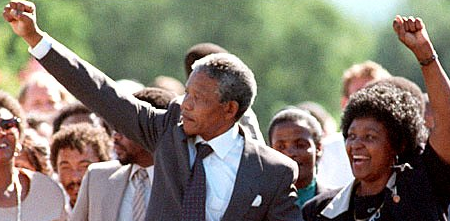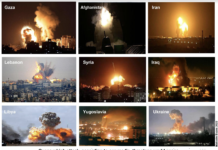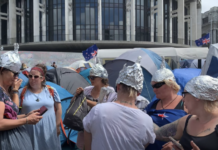The first picture of a contemporary Nelson Mandela that I saw in my lifetime was one of him and de Klerk published shortly before his release from 27 years of imprisonment in 1990. They were standing in de Klerk’s Presidential office and the photo made Mandela look like he had a funny lip.
His image had been banned for more than a quarter century but his moral force in having organised resistance and defied the regime meant he was the liberation leader to the people on the street. He was the one the Afrikaaners would have to deal with if they weren’t to be overthrown and then exist on black nationalist terms without political or social security from the new state. All accompanied by bloodshed.
The typical boer being what he is I figured this compromise point would never happen – the latter-day Nazis would never compromise armed with such an elaborate plan as Apartheid and a mentality 300 years in the making. The white countries, like NZ under Muldoon, the UK under Thatcher and the US under Reagan, supported the regime’s racist exploitation of the Africans under the cloak of anti-communism. Why wouldn’t this continue into the 90’s, the 2000’s and beyond? The Springbok Tour of 1981 divided the nation, families, friends into those who liked rugby and were thick racists, and those who liked rugby but not with countries run by thick racists. The sad thing was as it turned out through a near civil war that about half the NZ population are thick/racist and only half the population aren’t and they went and elected Muldoon again.
NZ supported South Africa. My high school in the 1980s had South African Airways posters in the geography room and we were supposed to think how cool Table mountain looked and how South Africa is a normal part of the international community, but all I thought was: does the Apartheid begin as soon as you get in the plane, or after you get off the plane? The diplomatic bulletins from Pretoria in the school library showed a map of South Africa fractured with bantustan ‘states’, just another normal country, good old South Africa.
I grew up with Mandela having always been in jail and thought he’d end up as a reverse Rudolf Hess doomed to die in old age still in captivity. The TV images of him walking up a dusty road as a free man with Winnie on his arm were joyous. Such a scenario was unthinkable even five years before.
Back then shotgun-wielding white policemen hiding in the back of a truck had open-fired and killed a group of black children on a street corner. It was a horrifying effect. The evil sadism behind Verwoerd’s euphamistic ‘good neighbourliness’ was exposed. Shortly thereafter the almost nightly TV news of burning tyres, sjambok whipping, dog biting and riots from South Africa just stopped. The regime had declared a state of emergency and the pictures stopped.
Behind the blanket censorship in the late 80’s it was getting more unstable and the vow to make the Apartheid state ‘ungovernable’ was being realised by the liberation movement. They didn’t last much longer and when the Berlin Wall was torn down from both sides in November 1989 it was to be less than three months later that the other iconic image of the age – a free Mandela with arm upraised in a fist – was to occur.
In between these events was the live broadcast of the 150th anniversary of the Treaty of Waitangi. When bishop Vercoe said in his speech that the Treaty had been a ruinous thing for Maori and the government was responsible – it literally had me choking on my cornflakes. Never before had anyone in such a position and on such an occasion ever said anything as direct as that to the Queen, the PM and the public. Not that I’d ever heard. Uncle Tom must have passed away because homie was definitely not playing that game anymore. After that event the questioning of the legitimacy of the Crown and the benefits of the Treaty became mainsteam discourse for Pakeha rather than a concern primarily of leftist academics and unionists. It was a revolutionary time.
And far from feet of clay, the aging Mandela had talons of steel. His personal intervention saved the nation time and again. His personality, strength and humour won over most. But it was not his Presidential inauguration speech or the long multiracial queues of voters in 1994 that signify the end of Apartheid to me. The image that confirmed the practice of Apartheid was terminated happened a month beforehand on a dusty road in a bantustan. An AWB Afrikaaner extremist paramilitary death squad had been shooting black villagers for sport under the guise of assisting the corrupt bantustan leader regain control under the weight of a strike. It was the last act of the whites to prop up the architecture of Apartheid. It was a murderous rampage. The bokmobile mercedes halts after it was fired upon, then bantustan police gather while the whites start getting steadily more cocky and demand an ambulance and so on. Talking to them like the next word would be ‘kaffir!’. After they identify themselves as AWB a policeman steps forward and asks: ‘why are you in my country?’. Since both of them knew the answer was to kill black people wantonly, the quick-witted policeman seeing the dilemma needed an immediate resolution opens fire and summarily executes them all. Right in front of the TV cameras. It’s not your country anymore, you can’t just kill us anymore without consequence. We don’t have to take your shit anymore. To me it was a sort of bookend to the trojan horse massacre. TV had delivered the counter-killing.
The other events of Mandela’s life, the Nobel Peace Prize, his presidential career with de Klerk in tow during the transition and everything since has shrunk into obscurity compared to his donning of the Springbok jersey for the IRB World Cup rugby final. That one symbolic act alone seemed to seal the future harmony of the new South Africa.
With Mandela’s passing it throws into contrast how far NZ has to go to reach the same stage of decolonisation that he acheived in a relatively short time. Jim Bolger and Doug Graham were the FW de Klerk and Pik Botha of NZ, but the selected tribes they chose to deal with had mortals like Bob Mahuta and Tipene O’Reagan instead of a Mandela.






[…] TV Review: Mandela By Tim Selwyn https://thedailyblog.co.nz/2013/12/10/tv-review-mandela/ […]
Comments are closed.